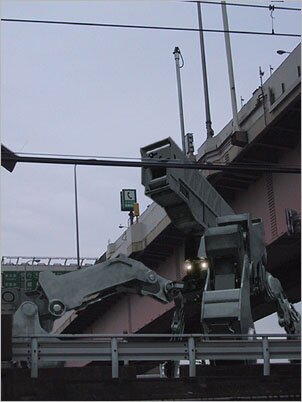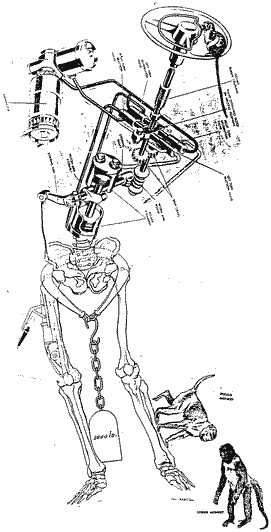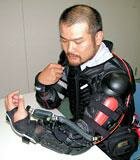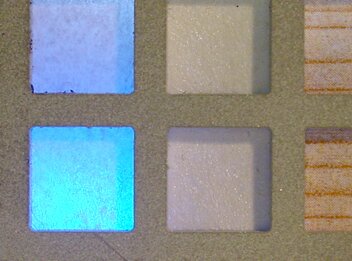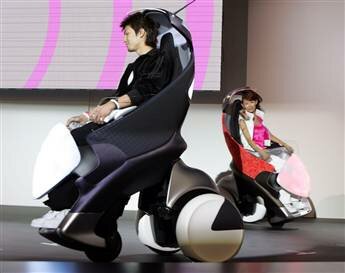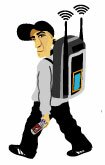October 31, 2005
Looking for Writers
I'm doing some work for "The Mouse"(*) for a few weeks and really need someone to help lighten the load of writing for this site. If you're a writer/blogger who is interested in the topics on this blog and would like to contribute, please contact me immediately.
Thanks!
(*)"The Mouse" refers to Disney
Wearable Computing Market
You probably knew that the market for wearable computing is growing, but here's some real research to back it up.
The global market for wearable computing and communications systems is expected to reach $270 million by 2007, according to a recent study published by VDC. Sales in this relatively small market are expected to grow more than 25 percent annually, based largely on the sales of customized solutions to two core market segments: warehousing and transportation. Smart fabrics and see-through wearable displays are on the horizon. Wearable systems spending is highly concentrated in warehouse and transportation/distribution market segments. Wearable devices allow users to keep their hands free for other activities during operation, which creates a compelling ROI in picking and placing, inventory tracking, and cross-docking applications that are core to these markets.
[ Link via Google News ]
NYC2123 Part 3 Online

Part 3 of the web comic NYC2123 is now online. Go check it out!
42 Ninjas Productions is happy to announce that Issue 3 of NYC2123:Dayender is now available at nyc2123.com. From our homepage, you can download Issue 3 as a zip archive of jpg files for viewing on your PSP, or you can simply read it online.
[ Link ]
October 30, 2005
Radical Cyborgs Tribe
Found a tribe on tribe.net called "Radical Cyborgs", which seems to hold some promise for discusssion. Here's the description:
Democratic transhumanists, revolutionary singularitarians, leftist extropians, bioutopians, socialist-feminist cyborgs, biopunks, transgenders, body modifiers, basic income, the culture, viridians.
One of the topics I really liked was "What cybernetic enhancement / device do you need?". Check it out, there's some fun comments there.
We are not free in this human society because we need to eat, to drink and to sleep. And even in a ideal techno-utopic society, it would be impossible to be free because we die.If we want to be free, before thinking of other possibilities, we would have to remove those needs.
Think of alga, maybe you think it ’s a lower being, and it is in some ways, but it doesn ’t need to kill to live. Alga gets its energy directly from sun.
What kind of device would we need to insert inside of our human bodies to be a kind of intelligent seaweed?
Nanotechnology Factory Video
Found a video of a nanotechnology factory. Can't really see it because of my connection, but I saw enough to see that it was something worth sharing.
Technoprogressivism: Beyond Technophilia and Technophobia
Interesting article on "Technoprogressivism", going beyond technophilia and technophobia. I'm interested in the politics of cyborgs and wearable computers, so to me, this makes a lot of sense.
A technophile is a person to whom we attribute a naïve or uncritical enthusiasm for technology, while a technophobe is a person to whom we attribute a no less uncritical dread of or hostility to technology. But what does it tell us that there is no comparably familiar word to simply describe a person who is focused on the impact of technology in a critical way that is attentive both to its promises and its dangers?Why is it that any technocentric perspective on cultural, historical, political, and social questions is always imagined to be either uncritically technophilic or technophobic? Is it really so impossible to conceive of a critical technocentrism equally alive to real promises and alert to real dangers?
October 29, 2005
Outdoor Security Robot
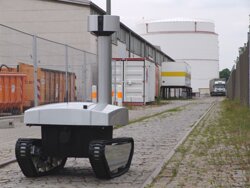
OFRO claims to be the first outdoor security robot... I'm not so sure about that, but this thing does look pretty threatening, even without an RPG or other weaponry strapped to that periscope like eye.
From what I can tell, this robot isn't waterproof, generally likes flat surfaces to do it's patroling, and relies on GSM / WLAN, so given a sophesticated intruder, could be easily overcome. Nevertheless, people are stupid, and expensive, so why not have a robot making the rounds? Maybe soon the robots won't be stupid like their fleshy counterparts though.
Here's a video of it in action.
[ Link via tetsu yatsu. Thanks tetsu! ]
October 27, 2005
Cyberpunk Manifesto
Ah, to be a cyberpunk. Here's the cyberpunk manifesto by Christian As. Kirtchev.
1/ We are those, the Different. Technological rats, swimming in the ocean of information.2/ We are the retiring, little kid at school, sitting at the last desk, in the corner of the class room.
3/ We are the teenager everybody considers strange
4/ We are the student hacking computer systems, exploring the depth of his reach.
5/ We are the grown-up in the park, sitting on a bench, laptop on his knees, programming the last virtual reality.
6/ Ours is the garage, stuffed with electronics. The soldering iron in the corner of the desk and the nearby disassembled radio- they are also ours. Ours is the cellar with computers, buzzing printers and beeping modems.
7/ We are those that see reality in a different way. Our point of view shows more than ordinary people can see. They see only what is outside, but we see what is inside. That's what we are - realists with the glasses of dreamers.
8/ We are those strange people, almost unknown to the neighborhood. People, indulged in their own thoughts, sitting day after day before the computer, ransacking the net for something. We are not often out of home, just from time to time, only to go to the nearby radio shack, or to the usual bar to meet some of the few friends we have, or to meet a client, or to the backstreet druggist... or just for a little walk.
9/ We do not have many friends, only a few with whom we go to parties. Everybody else we know we know on the net. Our real friends are there, on the other side of the line. We know them from our favorite IRC channel, from the News-Groups, from the systems we hang-around:
10/ We are those who don't give a shit about what people think about us, we don't care what we look like or what people talk about us in our absence.
11/ The majority of us likes to live in hiding, being unknown to everybody except those few we must inevitably contact with.
12/ Others love publicity, they love fame. They are all known in the underground world. Their names are often heard there.
But we are all united by one thing - we are Cyberpunks.
Also I found this list of cyberpunk fiction, which is the kind of thing I should get my friend and avid reader, dragoon, to add to.
List of HMD & VR helmets
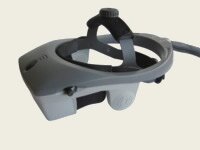
Christoph Bungert has made a list of HMD and VR helmets, which lists things like price, resolution, number of panels, and more. I think this is the kind of community resource that really helps people who are interested in working with mediated reality / augmented vision.
The only thing it's missing is editorials!
October 26, 2005
Geospatial Vibrating Belt
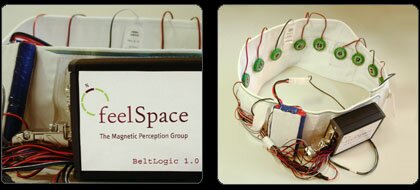
This geospatial vibrating belt called FeelSpace seems pretty interesting, and has a lot of potential to help aid the blind potentially. It currently is designed to "point" to north all the time, but with a bit of sonar, I'm sure it would be a lot better.
This belt is equipped with a set of vibrators controlled by an electronic compass: the element pointing north is always slightly vibrating. That way, the person wearing the belt gets permanent input about his heading relative to the earth's magnetic field.
Passports to get RFID chip implants

You probably already knew that people hated the idea of RFID in passports, but now there's some data to back it up!
2019 comments listed security and/or privacy; 171 listed general objections to use of the data chip and/or the use of RFID; 85 listed general objections to use of the electronic passport; 52 listed general technology concerns; and 8 listed religious concerns. Overall, approximately 1% of the comments were positive, 98.5% were negative, and .5% were neither negative nor positive.
Oh, but these surveys aren't done to decide on whether or not we should adopt RFID into our passports, they're only a way to make us feel like we might have an impact. The Bush administration is going right ahead with this plan, and they have eery 1984 plans to adopt iris and fingerprint scanning technology.
All U.S. passports will be implanted with remotely-readable computer chips starting in October 2006, the Bush administration has announced.Sweeping new State Department regulations issued Tuesday say that
passports issued after that time will have tiny radio frequency ID
(RFID) chips that can transmit personal information including the name, nationality, sex, date of birth, place of birth and digitized photograph of the passport holder. Eventually, the government contemplates adding additional digitized data such as "fingerprints or iris scans."Over the last year, opposition to the idea of implanting RFID chips in passports has grown amidst worries that identity thieves could snatch personal information out of the air simply by aiming a high-powered antenna at a person or a vehicle carrying a passport.
[ Link via boingboing via politech ]
October 25, 2005
RoboNexus Photo
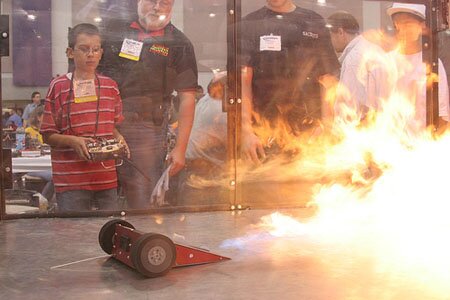
I'm not completely sure what's going on in this photo from RoboNexus, but it looks like two robots may be fighting, and there's definately fire involved, which if you read igargoyle regularly, you know I like.
Robofetish Imagination

Robofetish alert! This is a really cool video of robots interacting with people in everday situations as visioned by VFX house, 1st-Machine-Ave in New York City. This CGI is so good that I didn't realize initially that the robots weren't real. In fact what tipped me off was that the walking robots were walking too well.


Wearable Barcode Scanner
Socket Communications announced today that they are entering wearable computing with a wearable barcode scanner that goes on your index finger and uses bluetooth. One can only assume that a device like this will need another unit on a person to recieve the data like a bluetooth enabled PDA or full fledged wearable computer.
"Socket is committed to delivering products to help companies improve the productivity and profitability of their operations," said Peter Phillips, vice president of marketing at Socket Communications. "Socket continues to expand our family of data collection and connectivity products in response to customer demands. This lightweight and extremely durable new offering will enable customers to collect bar coded data hands free without being tied to a mobile or desktop computer."
I can certainly see the potential of this wearable barcode scanner for business use, such as clerks in supermarkets, or for doing warehouse inventory. Limited production of this product will be done in the last quarter of this year, and full production will begin beginning next year.
[ Link ]
October 24, 2005
Mac Mini Robot
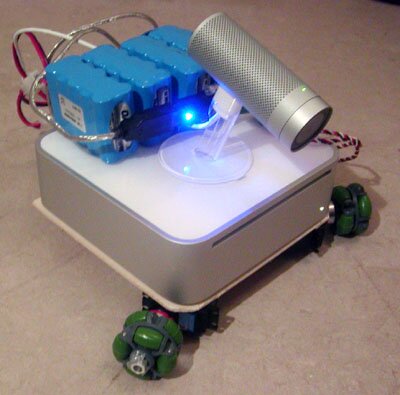
A Robot based on the Mac Mini! It even uses an iSight to do vision control and is autonomous. Cult of Apple fans rejoice!
Muscle Therapy Jacket
This muscle therapy jacket seems a lot like the inflatable exoskeleton we just saw from Japan, but more elegant, instead of the previous anime-like creation.
A robotic jacket that helps stroke victims recover from partial paralysis could be ready to wear in the near future.The device-essentially a mesh jacket in form-uses sensors to detect the muscle movements in the patient's healthy arm and wrist, then uses artificial muscles to stimulate that same movement on the damaged side of the body. Researchers hope repeated therapy will bring back the regular functioning of the damaged limb.
"If (the use of) this jacket spreads, it will be possible to provide long-term support for patients at home," said Akio Nakagawa, professor of occupational therapy at Kobe Gakuin University.
He was part of a robotics research team at the university that worked in conjunction with Osaka University and Activelink Co., a subsidiary of Matsushita Electric Industrial Co. in Seika, Kyoto Prefecture.
Clinical trials will soon be conducted with the jacket.
[ Link via we-make-money-not-art ]
Digital Picture Key Chain
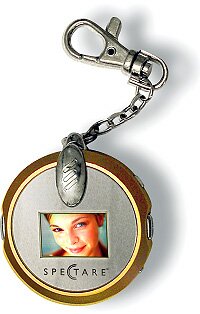
Tao has released a Digital Picture Key Chain, which is designed for those who have short lasting loved ones, or ever changing significant loved ones. Even better, it can hold 56 images, which can be used for those who have multiple significant others, and wish to seem devoted to each.
Personally, as much as I like high tech, I'd only really like this product if it was animated or did something other than show static photos.
Common, innovate people!
October 22, 2005
Wearables For Health
Businessweek.com did a report on health monitors recently, which many would like to be a ubiquitous part of their lives. These devices are becoming more and more portable, from arm bands, to fabric embedded electronics.
Fabric-embedded electronics are no longer science fiction and the health industry in particular seem keen to develop its potential, perhaps because 'gear' is already an integral part of it.A product that now is taking off is a "stress band", which is worn on the arm and collects data on the wearer's physical state. Until recently, the band was a research tool used to measure the stress in drivers but now, the Fitness Group Apex are promoting the band for consumers as a weight-loss monitoring tool.
Similarly, a shirt developed some years ago by VivoMetrics - which collects and analyzes its wearer's respiration flow, heart rate, and other key metrics - is already used in top medical schools and drug companies. The garment, which collects and analyzes its wearer's respiration flow, heart rate, and other key metrics, can allow researchers to see in real time whether a new treatment is working.
This article also gets into the real guts of smart fabrics with this paragraph about developments over the last two years:
DuPont created new fibers called Aracon, made of Kevlar, that are superstrong, can conduct electricity, and can be woven into ordinary-looking clothes. And chipmaker Infineon developed chip packaging allowing wearable computers to be washed, even in the heavy-duty cycle.
Now that's some tech I'd like to get into!
[ Link via Guerrilla-Innovation ]
Robotic Chimp Head

You too can own a robotic chimp head for 150 bannanas that will screech, say "AH-ahhhh" and "Eee-EEEEEEE!". It's made by the same people as the Robosapian, and is being sold by the Sharper Image stores. There's a windows meda video that is pretty interesting to check out. The movement looks good good, but I've never seen a monkey or chimp with teeth that white. Maybe marketing decided it would sell better that way.
[ Link via boing boing ]
Smart Fabric Talk in Quebec
The reality of smart fabrics and nanotechnology as a part of electronic clothing and wearable computing will be discussed by assistant professor, Joanna Berzowska at Concordia University in
Montreal, Québec on November 25th. She received her Masters of Science from MIT for her work titled Computational Expressionism. She also built a color changing fabric called "electronic plaid".
In this talk, I will outline the field of wearable technology: research directions, commercial applications and artistic practice. I will also discuss my research in one particular area of this large space: visually animated textiles that enable a SOFT reactive addressable display. I will show E-Ink prototypes, "Electronic Plaid" prototypes developed at International Fashion Machines and several simple experiments in "soft electronics" for wearables. Conductive yarns and fabrics, thermochromic inks and flexible sensors allow the construction of soft electronic garments. The goal is to achieve the seamless integration of technology into the tradition of textile and fashion design.
October 21, 2005
Robot Sniper Detector
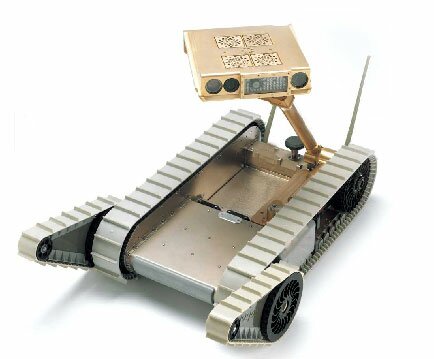
iRobot has made prototype robotic sniper detection system, called Redowl, as part of their military grade PackBot. The PackBot is a robot that is small enough to be carried on the back of a soldier, and has been carted around by it's human slaves many times already over in iraq.
Redowl features a laser pointer and illuminator, an acoustic localizer and classifier, a thermal imager, GPS (Global Positioning System), an infrared and daylight camera, and two wide-angle cameras.In field tests, the PackBot-Redowl combination had a success rate of 94 percent in locating the source of rounds fired from 9mm pistols, and M-16 and AK-rifles, at a range of more than 100 meters, the company said.

Above: Robot dreams of the day when he can kill humans.
[ Link ]
Visual Spam Blocker
Mediated reality product, "See-Free" promises a solution to all those pesky billboards that clutter the landscape by masking them out.

Steve Mann and his students originally broke ground in this area, which they call the Reality Window Manager (see below).


See the Reality Window Manager Video
On the other hand, "See-Free" only offers pictures on their website, which made me wonder how well, if at all, their product worked. Hell, I can photoshop a pretty good mask job, but it's completely another thing to engineer a solution to masking all billboards, all the time. I wrote them to find out more, but so far they've declined to comment.

Notice that with their example photos there are things in the
foreground of the billboard, which may be possible, but I kind of
doubt it.
RoboChrist - Take That!
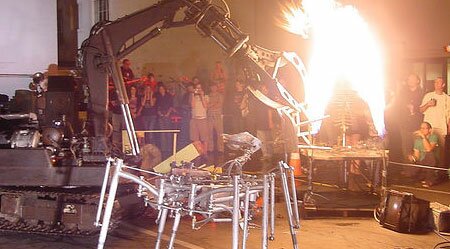
Not sure what show this is from, but it's definately Christian Ristow's robots.
October 20, 2005
SRL German V-1 Pulsejet
Ah, the smell of a German Pulsejet in the morning! I'm trying to expand the scope of this blog a bit to include some of my more dangerous interests, like Survival Research Lab's mounted V-1 pulsejet, which they recreated from WWII's "buzz bomb", a breakthrough missile that Germany fired 8,000 times on London.
This engine was a masterpiece of simplicity and heralded in the dawn of what we now know as the cruise missile or unmanned aerial vehicle (UAV).Little was known about this engine until the end of WW2 when the allied forces were able to examine a number of complete and partly constructed V1s recovered from formerly occupied territories along Europe's western coastline.
When SRL originally built their V-1, it wasn't an exact replica of Germany's V-1. Due to a lack of machine tools, they didn't have an exact valve intake assembly. It wasn't a major problem, except that each time the engine was run for any length of time, several valves would break off and disappear.

When they finally were able to build a proper valve intake, they decided to run the thing, which you can see in this test video. The best part is the end where a crowd of firemen show up and SRL has to explain why they have a gigantic jet that spews fire and acts as a frequency generator in their work yard. The best part is while he's explaining why they're recreating weaponry from WWII, he's eating like it's no big deal, and the firemen decide to leave after he tells them they're not going to run it any more.

Above: SRL's new and improved valve intake assembly for the V-1 pulsejet.
Here's a couple of videos of buzz bomb launches to give you some insight into what this thing was capable of. For more information on the design, see this.
[ Link ]
Mars Space Suit Design
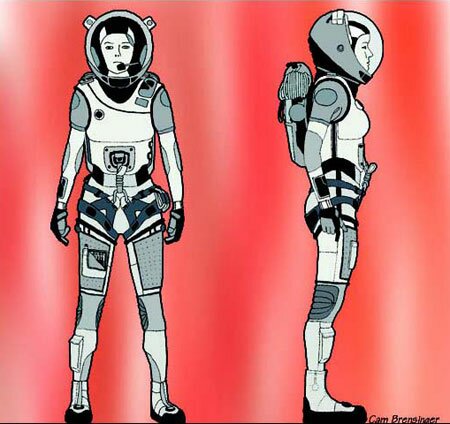
If we're going to Mars, we need new space suits. Last month, NASA announced plans to return to the moon by 2018, to use as a launching pad to Mars. In order to do so, a new space suit would be needed, and something less bulky would greatly improve the astronaut's ability to maneuver, especially as the old space suits are reffered to as "gas bags".
The proposed BioSuit will consist of a skintight body suit, a hard torso and backpack for life-support systems and equipment, and a domed helmet. The conceptual images for the project look like science fiction: sleek, color-coded spacemen and spacewomen climbing Martian windmills, whacking red rocks with hammers, and casually shaking hands.
Newman, a professor of aeronautics and astronautics, who is taking up the challenge of building a new space suit based on designs made by Paul Webb in the late 1960s says "I just marvel at it, ... Every day, I look at the skin and say, 'How could this be designed so fantastically?' "
[ Link via we-make-money-not-art ]
VIA Roboteq Robot Platform
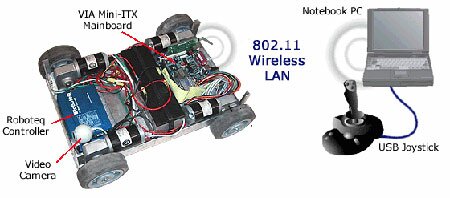
VIA Roboteq has a cool looking robot platform that looks like a remote control car, but communicates via 802.11, so it's compatable with wireless lans. It is based off the VIA Mini-ITX, which is pretty droolworthy,
Uber Badge: Wearable Badge for Social Interactions
The Media Lab at MIT is improving on previous wearable badges with the UbER-Badge, which uses infrared and RF to create connections between people and systems. Some of their aims are to do viral message passing like "Memes don't exist, tell your friends", location tracking by displaying on nehibor's badges the last time they saw that person, social networking, storing contacts for later retrieval, and more.
The Ubiquitous Experimental Research Badge (UbER-Badge) is a powerful platform for developing new applications in person-person and person-event interaction. This design takes a huge stride beyond the Media Lab’s previously successful badges (e.g., the Meme Tag (1998) and Thinking Tags (1997)). It is highly evolved in both its technological power and its aesthetics.This Badge is a general computing platform for experimentation with distributed systems and the analysis and enhancment of group social interaction. Although The Badge will be used in crowds of circa 200 people during Media Lab events, it is designed to be open and expandable for future research use, able to encompass essentially any crowd size and a host of possible applications.
All their software is open source, and looks pretty neat. I saw some of MIT's earlier badge/wearable computing work at ACM1, and it was pretty cool. Not very usable by a mass market, but still very promising.
RFID Pocket Protection
Since RFID tags may be sensitive, and are easy to steal information from, some textile hackers built a faraday cage for their jean pockets. They replaced their cotton pockets with electromagnetic field shielding fabrics, which can be bought online for about $13USD per foot. The guys who did this simple hack even have a howto video to watch.

I imagine this fabric would restrict cellular frequencies too, and would be a good substitute for tin foil hats.
October 19, 2005
RoboChrist at Burning Man
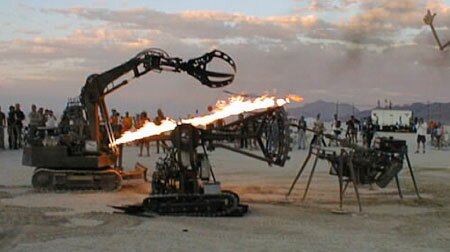
RoboChrist Industries (aka Christian Ristow and gang) put on a performance of their leathal robots at Burning Man in 1999.
[ Link ]
Wearable Vehicles?
Toyota car designer Hideo Miwa, who recently unveilled the i-swing concept car, which looks like a big chair on wheels, says that he sees a future in wearable vehicles, and I assume he's not talking about rocket powered roller-skates.
It can travel on three or two wheels, and its body is made of polyurethane and covered in fabric — to soften the impact if it bumps into people, Toyota says....
The i-swing — a “concept car” with no plans for commercial sales — is an upgrade of earlier concept cars designed to help with what Toyota calls “personal mobility,” meant to blend in with pedestrians on the streets.
That’s why the automaker chose soft material for the i-swing’s body, and the ultimate goal would be to make a wearable vehicle, Miwa said.
I would love to hear more about his vision. Obviously cars are heavy, but also offer protection on the road when going high speeds. What does this designer have in mind?
[ Link ]
Cyborg Cells
Cell research is breaking new ground for cybernetics, thanks to the University of Nebraska. Bacteria have been successfully used as a humidity sensor, and aparently still change shape in response to humidity even a month after they die.
Living bacteria have been incorporated into an electronic circuit to produce a sensitive humidity gauge.The device unites microbe and machine, taking advantage of the properties of both to make for a supersensitive sensor.
"As far as we know, this is the first report of using microorganisms to make an electronic device," says Ravi Saraf, a chemist from the University of Nebraska, Lincoln, who developed the 'cellborg' with his student Vikas Berry.
While this is taking the approach of embedding cells in electronics, instead of electronics in humans, it still is a big step forward to merging flesh and technology.
[ Link via we-make-money-not-art ]
Cyborg 101
Cyborg 101, aka "Warrior's Guide to the Blackboard Jungle" is an online book written by Angus T.K. Wong that expores cyborgs. Reprinted by Grasshopper Enterpises, and preserved by the Wayback Machine, this is a romp through cybernetic technology.
Nowaways, the term "cybernetics" has taken on new meaning. It describes the interaction between humans and machines. In fact, the "cybernetic relationship" requires that there be little distinction between the component organic and mechanical parts. A person with a surgically-implanted device, such as a pace-maker, is a prime example. The key to the use of the word "cybernetics" in the context of this book is to realise that cybernetic devices enhance organic functions. I will discuss not only cybernetic hardware, but cybernetic principles as well. In the competitive world of the urban jungle, it takes more than animal instinct and brute force to survive. Indeed, these two traits, so vital once long ago, may even be counter-productive in this day and age. Because of our biological limitations, and because of the modern demands placed on every person to perform at higher levels, it is foolhardy not to take advantage of advanced technology to assist us in our endeavours. It is this cybernetic assistance that I will show you.
October 18, 2005
Robot Village - A New York Robotics Store
A robotics store called "Robot Village" has opened up in New York, offering only robots and robotic supplies. They have robotics workshops for children, and plan to expand to have robotics classes in the evenings for adults too. Even cooler is that they're offering robot paries for kids!
We bring the party to you! Each event includes a hands-on demonstration with a variety of robots and a choice of robotic themed activities, including building and decorating motorized robots.Includes a birthday present for birthday child and everyone gets to take home the robot they create. Party options such as decorations, food, and more complex activities are available.
Wow, check out their calendar. This is really one cool store, I wish they had one in my town!
[ Link via boingboing ]
More Christian Ristow Robots

Here's another photo of a Christian Ristow robot, which was taken by my brother, Ordaos.
Believe me, this robot is pretty fucking scary in person, it would swing around really fast, and come really close to smacking people in the face with it's extended 'mouth'. Plus it did a good job chewing up a big Apple monitor.
Wearable WiFi Server
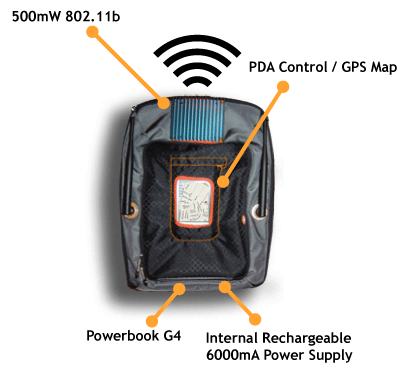
This project is a wearable computer with a WiFi node that attempts to provide services specific to that one node instead of becomming a bridge to the internet at large.
The WiFi.Bedouin consists of a small backpack containing an adapted 802.11b access point, RF amplifier, custom power supply and a PowerBook G4 running custom software, MovableType Blog software, a custom chat application, Apache 2.0, the Tomcat Java Servlet Container, and WiJacker - a custom built application that translates arbitrary named URLs to local services. A PocketPC PDA - the iPAQ 2200 - is mounted to the front of the WiFi.Bedouin pack, and is configured with its own 802.11 card. The PDA is used as a visual display for a custom GPS mapping application (mStory), for node WiFi activity, and for simple configuration.
The services it's aiming to deploy to the people around it are a Web Server, Chat Server, Shared Blog, and Streaming iTunes Music. In addition he indends to hijack any requests to any non-local websites to his own.
Wearable Controller for the iPod
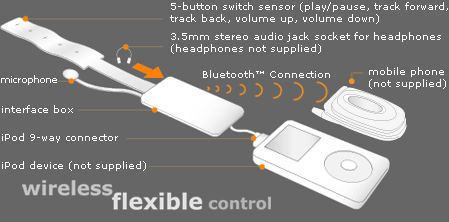
Well, you've probably heard about jackets with embedded controls for MP3 players, but this controller from Eleksen seems a lot more practical in my opinion because it's not tied down to any piece of clothing.
It's bluetooth equipped, and has a fabric controls, as well as a microphone, and as an added bonus, you can answer phone calls with it if you have a bluetooth equipped phone.
October 17, 2005
Your Own Cyborg Child
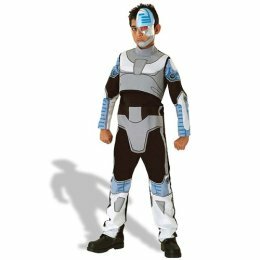
You too can own a 4-6 year old small cyborg child.
Teen Titan Cyborg Child - Small 4-6 Web Only $28.99
The specs are a bit sparse though, no idea if the child comes with bionic legs to jump over small buildings, or lasers in it's eyes, but it's a good deal. You can't even get a regular child for under thirty dollars.
[ Link ]
DIY Railgun

I seem to be finding a lot of mechanical type links today instead of the usual wearable computing roundup. I justify this post by saying "What self respecting cyberpunk wouldn't want a railgun?". Well for those who are interested in building such devastating backyard ballistics, there's a railgun blog to learn more about the art and science of high speed projectiles.
[ Link to the Railgun Blog via Hack A Day ]
Zombie Eating Robot
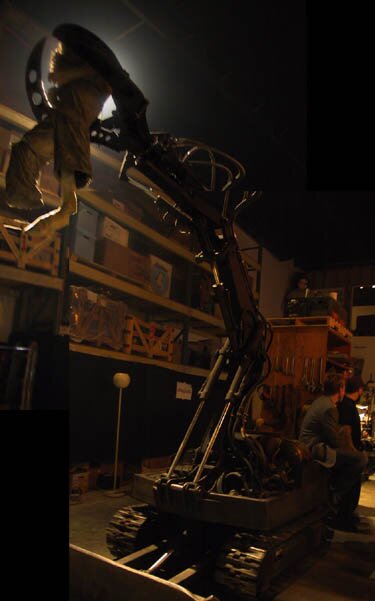
Here's a picture of one of Christian Ristow's extremely dangerous robots that my brother took at one of his smaller performances which was held at his studio at the Brewery in Los Angeles. I'll post about Ristow and his group, RoboChrist, throughout the week.
Flamethrower Robosapian
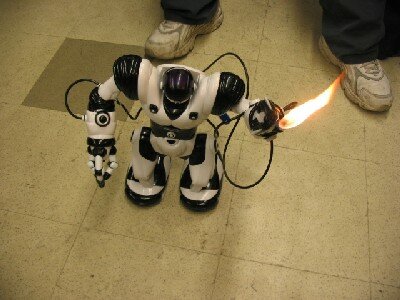
Robosapians are cool, but wouldn't a Robosapian with a flamethrower be cooler? Most robotics is more fun when it's dangerous, and even though this robot is tiny, we have to give it's hacker, Adam Plavinskis credit where credit's due; Good job, keep up the good work!
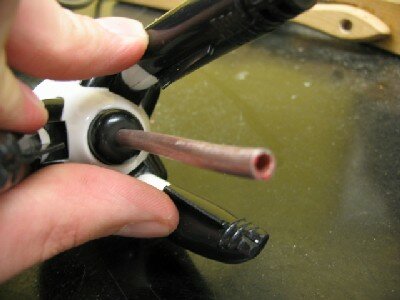 .
.
Next week on igargoyle, Flamethrower Robosapian vs The Subjugator! WHO WILL WIN?!?!
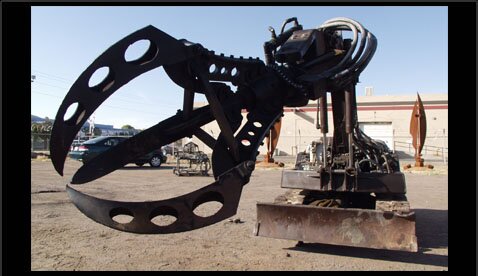
Above: Subjugator by Christian Ristow
[ Link via somewhere > OhGizmo > The Raw Feed > Clubbing Baby Seals > Hack A Day ]
October 16, 2005
MoMA's SAFE Exhibition Photos
I just wrote about this, and lo and behold, teh intarweb delivers me with photos. Here are my favorites from an amazing photoset from Core77:
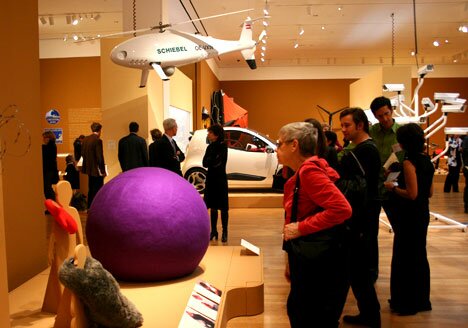
SAFE : Design Takes On Risk, the first major design exhibition at the New York MoMA since its reopening featuring more then 300 products designed in response to Psychological and Physical Threats.
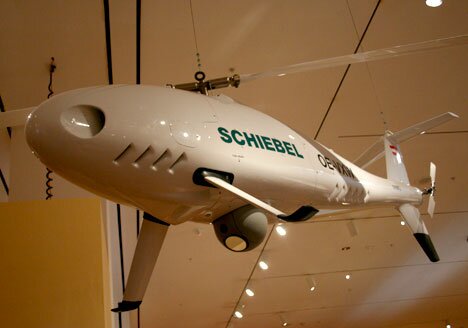
The 'Camcopter S-100' by Gerhard Heufler is a compact and lightweight helicopter with an autonomous flight-control system, was originally designed for aerial mine detection by the company Schiebel.
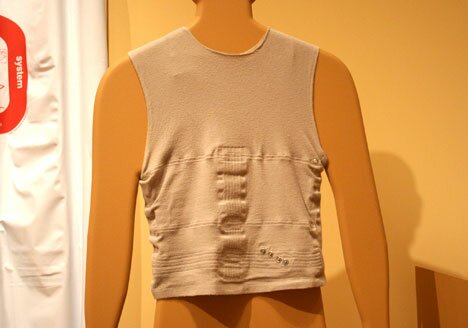
The 'Motherboard Shirt', by the Georgia Institute of Technology, has built-in sensors that are attached to the soldier's body and to monitor worn at hip level. It is activated when there is a break in the circuit, signifying a bullet wound. The Monitor records the vital signs of the soldier and relays the information to an on-site medical triage unit.
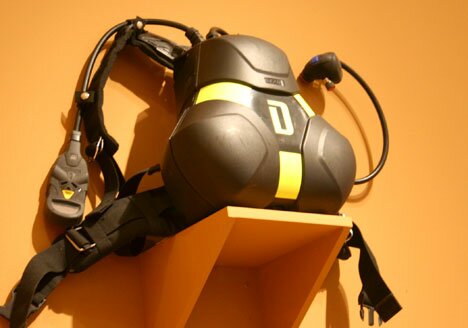
The 'DraegerMan PSS 500 Air Unit for firefighters' by Jakob Wagner.

The Securitree transmitter. Created by Raul Cardenas Osuna.
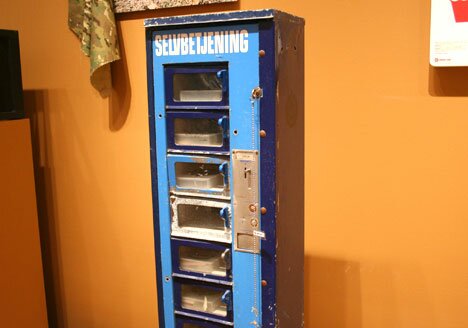
How to Disappear kit and vending machine. The kit can be purchased from vending machines located on city streets. Inside an anonymous video-cassette case, the buyer will find a booklet with instructions on how to dodge surveillance in public places, alsong with a selection of "disappearance gadgets".
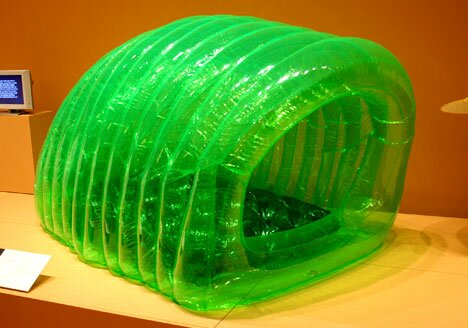
The 'Urban Nomad Shelter', by Cameron McNall and Damon Seeley, is created to provide an inexpensive and well-designed shelter for the homeless. The bright colors and the use of translucent vinyl, ensure that the homeless are visible, which is important to ensure their safety.

The 'See and Be Seen Parka', by Adam Thorpe and Joe Hunter allows the user to notice what is happening behind him.
And bonus, MoMA has put up a flash interactive exhibition on their website. Nice.
October 15, 2005
SAFE: Design Takes on Risk

SAFE: Design Takes On Risk, the first major design exhibition at MoMA since its reopening in November 2004, presents more than 300 contemporary products and prototypes designed to protect body and mind from dangerous or stressful circumstances, respond to emergencies, ensure clarity of information, and provide a sense of comfort and security. These objects address the spectrum of human fears and worries, from the most mundane to the most exceptional, from the dread of darkness and loneliness to the threat of earthquakes and terrorist attacks.
From we-make-money-not-art, I found out about one of the other things that will be shown at MoMA in the SAFE exhibition. Suited for Subversion by Ralph Borland is a wearable art piece which uses both low and high tech to create a political statement and padded target for riot police.
Suited for Subversion is a project to create a suit that protects the wearer at large-scale street protests. The suit also monitors the wearer's pulse and projects an amplified heartbeat out of a speaker in the chest of the suit.
I really like this suit, even if it does look pretty strange. It reminds me of this idea I had for a suit that would stick out spikes when the user felt threatened, much like a blow fish. Ralph Borland's suit on the other hand seems to engage conflict by use of the bright red color, but also discourages it by vocalizing the wearer's heart beat.
SAFE: Design Takes on Risk looks really cool, I wish I had some time in my busy schedule to go cover it in person.
[ Link via we-make-money-not-art ]
Liteye in Iraq

Found this picture of an Liteye 450 on a soldier in Iraq. I really wish I could find more pictures of civilans though, but wearable computing aint cheap.
[ Link ]
October 13, 2005
iBreast: MP3 in your Tits

One boob could hold an MP3 player and the other the person's whole music collection....
BT Laboratories' analyst Ian Pearson said flexible plastic electronics would sit inside the breast. A signal would be relayed to headphones, while the device would be controlled by Bluetooth using a panel on the wrist.
Ian Pearson said to the British tabloid, The Sun, "It is now very hard for me to thing of breast implants as just decorative. If a woman has something implanted permanently, it might as well do something useful.". I tend to agree, but the idea of having legacy hardware in one's body isn't too exciting either, and really, who wants to be fondling someone's tits, only to have France Ferdinand start playing?
All kidding aside, there is potential in this kind of development for things like medical equipment to detect heart murmurs, blood pressure increases, and breast cancer.
October 12, 2005
Microvision Ruggerdizing Military HMDs
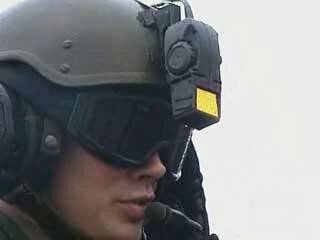
Under the contract, Microvision will deliver prototypes that meet or exceed military standards. General Dynamics C4 Systems awarded the subcontract.
Here's a video of their current military gear.
[ Via nwsource.com ]
October 11, 2005
Internet Addiction

China thinks internet addiction is an epidemic. Stranger is that they think this Clockwork Orange like device will help them overcome it. Maybe they should just gouge out their eyes instead.
[ Link via /. ]
October 04, 2005
Chick Magnet
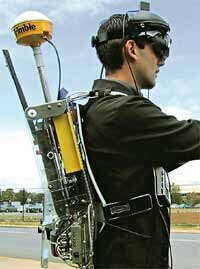
Well at least they have a sense of humor...
The wearable system is called the Tinmith Endeavour backpack, more affectionately called "the chick magnet" by the research team.Dr Thomas concedes much work needs to be done to reduce the size and improve the usability of the unit.
[ Link ]
October 03, 2005
Seoul to Build Combat Robot
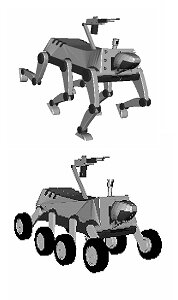
According to design blueprints released during a meeting of science-related ministers, the robot will have six or eight extendable legs with wheels allowing it to move like an insect over uneven terrain.The robot will be armed with various weapons and will operate both by remote control and its own artificial intelligence system.
Even if they are deadly, I'd love one to harass and play with my brother. Ah, good times.
[ Link via Tetsu Yatsu ]
“Borgs” By 2045
Ray Kurzweil, who has a new book called "The Singularity is Near: When Humans Transcend Biology", is predicting that a borg singularity, like that of Star Trek. His prediction is based on Moore's Law, which when applied to current techology, claims that by 2030 a $1 computer will be as powerful as the human brain, which lends to the transfer of a brain to computer, or at least a merging of the two.

Your concept of the future relies heavily on "strong AI," the idea that artificial intelligence will become self-aware and eventually surpass human intelligence. But it seems like AI researchers have abandoned that idea for focused real-world applications like face recognition. I was at a speech this week where computer science professor Rudy Rucker said that strong AI was dead.Kurzweil: There are hundreds of applications where AI is performing projects that would have required a human level of intelligence a few years ago. Those include diagnosing heart disease, routing e-mail messages, cell phone routing, landing planes.
We are now in an era of narrow AI, meaning it's not strong AI. It's not the full range of human intelligence. But it's performing functions that used to require human intelligence. Looking for credit card fraud is one example of that. These were research projects 15 years ago.
This isn't 2029. We'll make a billionfold increase in hardware capacity between now and then. We're also doubling the resolution of brain scanning every year. So it's a long case, which is why it took a whole book to express it. But we'll have the hardware and software in the 2020s for strong AI. We're a factor of a billion (away).
The tools we have to model the brain, to scan the brain, to simulate these processes, all of these are doubling every year. What that means from the perspective of the 2020s is that it's a very doable project.
I tend to be on the verge with this one; technology has limitations, which lend to coming up with dramatically different solutions to computational problems, but that really comes down to what you think of Moore's Law. I'm also unsure about AI's ability to really make complicated decisions when they still make lousy opponents in video games.
October 02, 2005
Austrilian Locative Artist Colab
For all the Australian artist geowanking geeks out there:
Organisers hope to tap into developments in so-called "locative media" such as global positioning systems, mobile phones and movement sensors.Dr Rackham said the way internet users had seized on Google's new mapping services, building new ways to navigate them and turning them into useful tools, showed how quickly ideas move from experimental to mainstream.
The 10 artists taking part in the media lab have worked with everything from three-dimensional internet interfaces to old-fashioned textiles, as well as the internal spaces created in video games and other computer environments.
The group organizing it is called ANAT. Maybe some cool art/tech will come out of it.
[ Link ]
October 01, 2005
Inflatable Exoskeleton
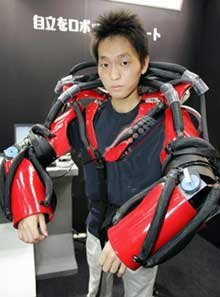
The suit mimics the body's system of connecting muscles to bones via tendons.It could be used to boost the strength of specific muscles, such as biceps or triceps.
The artificial muscles are made up of inflatable rubber tubes surrounded by flexible metal mesh connected at each end to the joints on the suit
When the tube inflates, the mesh bulges, which in turn pulls each end in and shortens the artificial muscle.
Pressure sensors all over the suit would tell the artificial muscles when to kick in.
These sensors sound a lot like the Segway, which detects small movements from a person, and uses those movements to decide to move forward, backward, or come to a complete stop. Having a grandmother who is not able to move as well anymore, I can see the significance of technology such as this. Check out the video of the suit in action!

[ Link via we-make-money-not-art. Thanks Reg! ]

